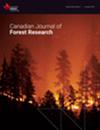Low-impact line construction retains and speeds recovery of trees on seismic lines in forested peatlands
IF 1.5
3区 农林科学
Q2 FORESTRY
引用次数: 2
Abstract
Seismic lines are linear features created by the oil and gas industry for energy exploration. Though individually narrow, collectively seismic lines are a pervasive management challenge, resulting in changes to biogeochemical cycles, plant and animal abundance and behaviour, predator-prey relationships, and forest successional trajectories. These impacts arise from historical construction methods that used bulldozers to remove vegetation and substrate leaving lines as persistent openings in a state of arrested succession. In the mid-1990s, “low-impact seismic” (LIS) line construction began, using mulchers to remove vegetation aboveground to minimize impacts and hasten reforestation. Here, we evaluated the effectiveness of LIS in retention, recruitment, and growth of seedlings in forested peatlands in northeast British Columbia. Retained and recruited trees on LIS lines were found at 69% and 64% of sites, had mean densities of 3,400 and 6,000 stems/ha, and mean heights of 42 and 11 cm, respectively. These LIS lines appeared to recover along expected trajectories toward tree cover, thereby mitigating challenges typical of older seismic exploration. Our results suggest it is feasible to further fast-forward line recovery by ensuring mulcher drums are kept as high as possible to increase the number and height of trees through the mulching process.低影响线路建设保留并加快了泥炭地森林地震线上树木的恢复
地震线是石油和天然气工业为能源勘探而创造的线性特征。地震线虽然个别狭窄,但总体上是一个普遍的管理挑战,导致生物地球化学循环、动植物丰度和行为、捕食者-猎物关系和森林演替轨迹的变化。这些影响源于历史上使用推土机清除植被和基材的施工方法,在演替受阻的状态下,留下的线条作为持续的开口。在20世纪90年代中期,“低影响地震”(LIS)线路建设开始,使用覆盖物去除地面上的植被,以尽量减少影响并加速重新造林。在这里,我们评估了LIS在不列颠哥伦比亚省东北部森林泥炭地幼苗保留、招募和生长方面的有效性。在69%和64%的地点发现了LIS系上的保留树和招募树,平均密度分别为3400和6000茎/ha,平均高度分别为42和11 cm。这些LIS线似乎沿着树木覆盖的预期轨迹恢复,从而减轻了传统地震勘探的典型挑战。我们的研究结果表明,在覆盖过程中,通过确保覆盖桶尽可能高,以增加树的数量和高度,进一步加快线恢复是可行的。
本文章由计算机程序翻译,如有差异,请以英文原文为准。
求助全文
约1分钟内获得全文
求助全文
来源期刊
CiteScore
4.20
自引率
9.10%
发文量
109
审稿时长
3 months
期刊介绍:
Published since 1971, the Canadian Journal of Forest Research is a monthly journal that features articles, reviews, notes and concept papers on a broad spectrum of forest sciences, including biometrics, conservation, disturbances, ecology, economics, entomology, genetics, hydrology, management, nutrient cycling, pathology, physiology, remote sensing, silviculture, social sciences, soils, stand dynamics, and wood science, all in relation to the understanding or management of ecosystem services. It also publishes special issues dedicated to a topic of current interest.

 求助内容:
求助内容: 应助结果提醒方式:
应助结果提醒方式:


